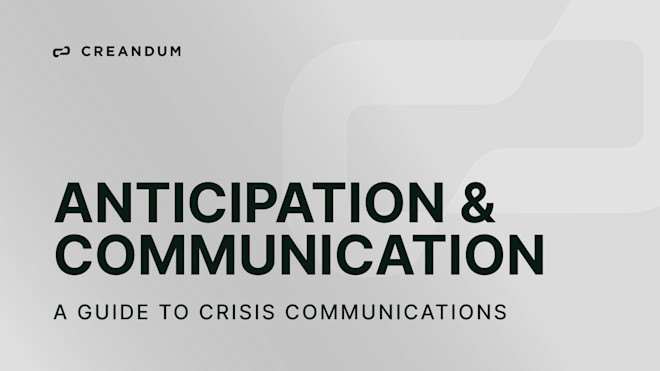
A Guide to Crisis Communications

Crisis comms 101
Co-authored with Ballou, a European communications agency working with high-growth tech companies and VCs.
Key takeaways:
During a crisis you are dealing with humans - you will be judged under the court of public opinion
List the risks as exhaustively as possible. A tailor-made strategy must be created, complete with developed scenarios and their precise stages
Crisis communication is about finding the perfect balance between what has been prepared and the reality of events as they unfold
The last few years have shown us just how uncertain the world we live in is. Unpredictable crises have disrupted the global economy and the way businesses, organisations and institutions operate.
These global crises exacerbate other critical situations to which companies and organisations are already exposed by the very nature of their activity. And while reputation is built through continuous effort, a simple mistake in crisis management can result in rapid collapse for enterprises, an unfortunate process that is accelerated and amplified by social media networks.
Crisis communication must therefore be given constant thought from the moment an overall communication strategy is put in place, taking into account all stakeholder needs.
Crisis communication needs to be anticipated as far as possible
Making a decision in a crisis often leads to mistakes. It's human nature: stressful situations impede the rational thought process, leading to excessively long reaction times or even immobility. In other words, establishing a communication strategy in the middle of a crisis will lead to favouring short-term solutions that will often inadvertently make the entire situation worse in the long run.
While it is difficult to predict when a crisis will occur, it is possible to anticipate how to communicate when it does. The first step is to list the risks as exhaustively as possible. This involves taking into account not only universal events such as climatic, geopolitical, financial or health hazards, but also those that are specific to the company's sector of activity.
To plan ideal responses to these potential risks, a tailor-made strategy must be created, complete with developed scenarios and their precise stages, all guided by a certain number of rules that can be relied on if and when the time comes:
What kind of crisis unit should be set up and who should be part of it?
When should you communicate?
What information should be shared and with whom?
Which spokesperson should represent the organisation?
To be truly effective, a crisis communications plan must be integrated with the business’ recovery plan. It is then up to public relations managers and associated advisers to work closely with the representatives of the organisation's various functions in order to obtain and relay reliable and exhaustive information, not forgetting the lawyers.
Communicating about a crisis means understanding it
No matter how well prepared, a crisis communication strategy is never ready-to-use. Above all, communicating in a crisis is about responding to human considerations and managing emotions such as fear, sadness, doubt or anger.
That's why approaching things from a purely legal point of view is a strategy doomed to failure. Crisis communication is about finding the perfect balance between what has been prepared in theory and the reality of events as they unfold.
The priority to remember in crisis communication, therefore, is to first determine your given situation’s origin, understand its seriousness, appreciate its scale, and then finally decide on the messages to be communicated and the appropriate channels for relaying them.
A crisis involves people, and it is the most vulnerable of people who must first and foremost be considered. A company's ability to recognise the problem, apologise (or not), explain the consequences and provide the solutions are vital to effective crisis management. Don't forget - what will be judged first and foremost is the human approach.
In a world where every opportunity is taken to speak out, silence is perceived as suspicious. However, communicating by choosing to play down the scale of the situation, while profitable in the short term, is a solution that risks disrepute. The key to effective crisis communication therefore lies in the way the truth is conveyed.
Crisis communication must be rapid but not rushed
If you fail to communicate in a crisis, you run the risk of making assumptions about the situation as it unfolds: in such cases, social media becomes your worst enemy.
The first statement given by a business post-crisis will determine the public's perception of how effectively that crisis is being tackled. A message that is too reassuring in a difficult context may give the impression that something is being hidden or not treated with appropriate gravity. Conversely, an overly serious tone, adopted as a token of credibility, may lead people to believe that the facts are much more serious than they actually are.
Crisis communication must therefore be as transparent as possible, including the causes of the crisis and the measures taken to remedy it. Similarly, it is always preferable to take responsibility for mistakes made and consequences caused to demonstrate that the situation is being taken seriously, whether critical or not.
When crises have long-lasting consequences, other means of communication need to be considered. These could be to reveal major information, such as figures, evidence or a redundancy plan, or scheduled information at fixed times in the form of "situation updates". This latter method has the advantage of reducing speculation from impatient commentators.
Crisis communication must be coherent
Of course, the message must be adapted to the audience, in terms of both content and form. While the general public will appreciate a straightforward message, an industry expert will expect a higher level of precision. That being said, no one will tolerate contradictory or confusing statements. Although it may seem obvious, today's means of communication and the codes that underpin them, particularly on social networks where the format is limited, are conducive to making mistakes, especially in writing where everything can be reinterpreted.
A crisis inevitably leaves its mark on the life of a company. While you can’t wish it away, you can ensure that these marks have as little impact as possible on your P&L. While crisis communication is one of the key levers in resolving a crisis, it is probably the most important action if an organisation is affected in order to retain the trust of its public. Neglecting communications in crisis events is a risk that should never be taken. Conversely, a methodical crisis communications plan, if executed properly and in a timely manner, can shield your brand from further fallout.


